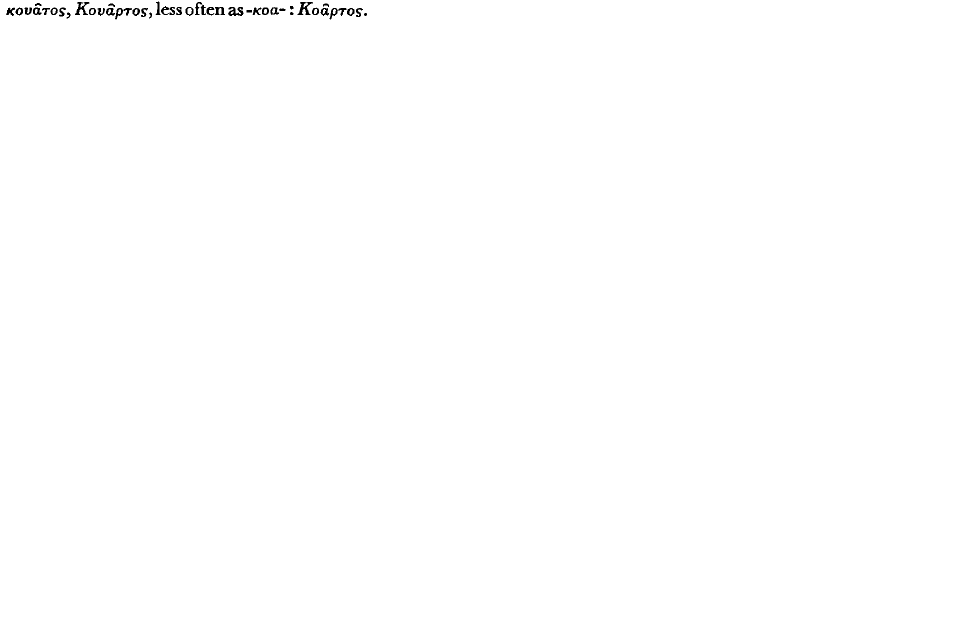Article contents
Two Linguistic Topics in Quintilian
Published online by Cambridge University Press: 11 February 2009
Extract
(Proposed text) Atque etiam in ipsis uocalibus grammatici est uidere an ahquas pro consonantibus usus acceperit, quia ‘iam’ sicut ‘tarn’ scribitur et ‘uos’ ut ‘cos’, at quae ut uocales iunguntur aut unam longam faciunt, ut ueteres scri-pserunt, qui geminatione earum uelut apice utebantur, aut duas,—nisi quis putat etiam ex tribus uocalibus syllabam fieri, si non aliquae officio consonantium fungantur. quaeret hoc etiam, quo modo duabus demum uocalibus in se coeundi natura sit, cum consonantium nulla nisi alteram frangat. atqui littera i sibi insidit— ‘conicit’ enim est ab illo ‘iacit’—et u, quo modo nunc scribitur ‘uulgus’ et ‘seruus’. sciat etiam Ciceroni placuisse ‘aiio Maiiamque’ geminata ‘i’ scribere: quod si est, etiam ‘i’ iungetur ut consonans.
- Type
- Research Article
- Information
- Copyright
- Copyright © The Classical Association 1963
References
page 1 note 1 Principal modern editions of Book I: by C. Fierville (1890), with full apparatus and bibliography; F. H. Colson (1924); M. Niedermann (1947—only the grammatical chapters, 4–8). See also L. Radermacher's edition, Part I, books 1–6 (Teubner, 1907). The grammarians are cited from Keil, H., Grammatici Latini, vols, i-vii (1857-1923).Google Scholar
page 1 note 2 Spalding, G. L., Quintiliani de Institutione Oratorio Libri XII, i (1798), 64.Google Scholar
page 1 note 3 e.g. Radermacher, Colson: iam, etiam, quos, tuos; Fierville, Niedermann: iam, etiam, uos, tuos.
page 2 note 1 Transcriptions and terminology employed here follow the visage recommended in The Principles of the International Phonetic Association (1949), pp. 4–19,Google Scholar except that the semi-vowels [j] and [w] are preferred to [i] and [u] for the second elements of diphthongs. [u] denotes a phone, / / a phoneme. Those who are unfamiliar with the linguistic terms and modes of argument used in this paper will find the following references helpful: Princ. I.P.A., p. 2;Google ScholarHockett, C. F., A Course in Modem Linguistics (1959), 2. 1–3.Google Scholar 3, 7. 1, 12. 1, 13. 1; Gleason, H. A., Introduction to Descriptive Linguistics (1955), 16. 2–14.Google Scholar
page 2 note 2 Donatus's canon that nulla uocalis geminata unam syllabam facit (on Ter. Andr. 173) is mentioned already by Velius Longus, 7. 58. 5–6, as being widely accepted by others. The objection of Quintilian's own teachers to uu (1. 7. 26) seems to be on different grounds, namely that uu can only form one syllable if the combination forms one sound, viz. /u./.
page 2 note 3 See p. 14, notes 1 and 3.
page 2 note 4 Nigidius's analysis (Gell. N.A. 19. 14) anticipates Quintilian's. His contemporary Varro called  uau (Priscian, 2. 15. 4, and Cornutus, 7. 148. 10 f.), thus explicitly equating it with f.
uau (Priscian, 2. 15. 4, and Cornutus, 7. 148. 10 f.), thus explicitly equating it with f.
page 2 note 5 Servius on Aen. 4. 549 says significantly that in the perfect tenses of obicere i becomes a consonant.
page 2 note 6 Marius Victorinus 6. 5. 21 f.: per se quidem proferuntur (like vowels) sed per se syllabam non faciunt (like stops). Prise. 2. 8. 7 follows Varro (Sergius 4. 520. 18) in relating the definitions to the names of the letters. For a comparison with the more sophisticated treatment by the Sanskrit phoneticians see Allen, W. S., Phonetics in Ancient India (1953), pp. 27–32.Google Scholar
page 2 note 7 Corn. 7. 148. 12 ff., Vel. Long. 7. 48. 8 ff. and 58. 4 ff., Terentius Scaurus 7. 12. 11 ff. and 17. 2 ff.
page 3 note 1 e.g. Vetter, E.Handbuch der italischen Dialekte, i (1953), 8, 12, 84, 88,Google Scholar 147. 6 (Capua), which cannot be much before 200 B.C., has no examples, and even after 150 B.C. the practice is not universal: 2 (Tabula Bantina) has no example, and 1 (Cippus Abellanus) uses the device inconsis tently.
page 3 note 2 e.g. Faliscan: aastutieis, uootum (C.I.L. i2. 364, 365Google Scholar); Greek:  , where the Latin part has only M. (ibid. 2239). Other Latin long vowels could be represented by normal Greek spellings: Tuscēnius:
, where the Latin part has only M. (ibid. 2239). Other Latin long vowels could be represented by normal Greek spellings: Tuscēnius: 
 Libō:
Libō:  Lūcius:
Lūcius:  etc. (ibid. 2236, 2240).
etc. (ibid. 2236, 2240).  for /i./ is frequent even after Latin /ei/ > /i./. It is perhaps significant that the Latin of these Delian inscriptions often exhibits dialectal features, e.g. magistreis, Mirqurio, and that many of the gentile names that appear in them, e.g. Oppius, Vicirius, Staius, are most frequent in Oscan-speaking areas of Italy.
for /i./ is frequent even after Latin /ei/ > /i./. It is perhaps significant that the Latin of these Delian inscriptions often exhibits dialectal features, e.g. magistreis, Mirqurio, and that many of the gentile names that appear in them, e.g. Oppius, Vicirius, Staius, are most frequent in Oscan-speaking areas of Italy.
page 3 note 4 The terminal dates here are given by paastores and aaceteris (C.I.L. i2. 638, 587Google Scholar). Among later instances are: quii, proxumiis once, beside frequent quei, proxumeis (ibid. 593, 40–41. 45 B.C.), sacriis (ibid. 594, 44 B.C.), fatiis (C.I.L. vi. 30975,Google Scholar1 A.D.), and diuii (ibid. 9005, 43–44 A.D.).
page 3 note 5 e.g. canum/cānum, uere/uerē, duxeris/duxeris, mantis/manūs.
page 3 note 6 Possibly manubiis (C.I.L. xi. 1831). The earliest certain examples are given in note 4.Google Scholar
page 3 note 7 Ter. Scaur. 7. 18. 12 ff. apparently accepts ii as an ‘Accian’ spelling, while M. Vict. 6. 8. 13 f. (if Keil's text is sound) attributes to Accius the preference for ei.
page 3 note 8 e.g. purgati (C.I.L. i2. 586, 160 B.C.Google Scholar) faxseis, dissoluendei merenti (ibid. 632, 133 B.C.) populi Romanei, agri, locei, etc. (ibid. 583, 123–122 B.C. and 584, 117 B.C.).
page 3 note 9 Vel. Long. 7. 56. 2 ff. and Ter. Scaur. 7. 18. 15 ff. seem to imply an artificial revival of the phonetic distinction between -ei- and -i- in connexion with these spelling reforms of Lucilius. In the latter passage Varro is apparently credited with the view that pueri/puerei should be distinguished, though the relevant part of the text, p. 19. 7–10, is very corrupt and difficult. Scaurus himself seems to have approved the distinction: facilis (nom., gen.), facileis (acc). See 7. 32. 21–33. 2. A desire to avoid the corresponding homophony of genitive singular and dative plural in the -u- declension would account for the forms senatuis and domuis, which Gellius (N.A. 4. 16) attributes to Nigidius and Varro.
page 4 note 1 Lindsay, W. M., The Latin Language (1894), p. 10.Google Scholar
page 4 note 2 Kent, R. G., ‘Dissimilative Writings for ii and iii in Latin’, T.A.P.A. xliii (1912), 35–56.Google Scholar
page 4 note 3 Earlier inscriptions show -iei-, -i-, and ei, but never -ii-, in the verb forms: e.g. redieit (C.I.L. i2. 626, 145 B.C.)Google Scholar, uenieit (ibid. 585, 11 / B.C.), peristis (ibid. 861, early first century B.C.), abit, obeit, etc., especially in rural areas (ibid. 2116, 2185). For ie instead of ii: adiesent, adieset, adiese (ibid. 581, 186 B.C.). The earliest epigraphic genitive singular in -ii is negotii (ibid. 594). Earlier -i, e.g. consili, iudici (ibid. 583, 585), still remains the commoner form in early Imperial inscriptions, cf. Charisius, 1. 79. 2.
page 4 note 4 For the restoration of -ii- generally see Vel. Long. 7. 57. 6 ff., Ter. Scaur. 7. 22. 4 ff., Char. 1. 78. 4 ff., 122. 6, where the analogist context of the reform is clear from the authorities cited: Lucilius, Varro, and Pliny the Elder. For the metrical evidence see Neue-Wagener, , Formenlehre der lateinischen Sprache (1902-1905), i. 134 ff., ii. 44–45.Google Scholar
page 4 note 5 Parallels to controuersis, floui (C.I.L. i2. 584Google Scholar), and olearei (ibid. 705, early first century B.C.) are rare before mid-first century, when we find: socis, librarei, fluui, aedificis, comitis, etc. (ibid. 1274, 593, 594). The apexed and long-letter forms generally begin in the first quarter of the first century B.C. and are common under the Empire, as Quintilian implies.
page 5 note 1 Cf. tibii = tibei, iiidus = eidus, iiriniii = Erinie, on Republican popular inscriptions (C.I.L. i2. 1012, 1061, 392).Google Scholar
page 5 note 2 Stroux, J., ‘Textprobleme aus Quintilian’, Philologus lxxxv (1930), 330–9. See Char. I. 11. 17, Prisc. 2. 44. 13, and for diphthongum defined, 1. 12. 11 f., 14. 20f.Google Scholar
page 5 note 3 Corn. 7. 148. 12 ff., Prisc. 2. 44. 10 ff.
page 5 note 4 Colson, F. H., ‘Some Problems in the Grammatical Chapters of Quintilian.’, C.Q. x (1916), 17 ff., and in his edition of Book I, p. 42.CrossRefGoogle Scholar
page 6 note 1 Cf. the spurious quod absurdum est in Tcr. Scaur. 7. 19. 11.
page 7 note 1 Consentius' use of infringere (5. 395. 5) for the palatalization of the dental in etiam and in the Greek pronunciation of optimus provides the nearest parallel. Stroux's suggestion that the term is borrowed from musical theory is obscurum per obscurius. Collidi is used of various collocations of consonants, e.g. by Quintilian, 9. 4. 37, and Pompeius, 5. 119. I4f., and of syllables by Diomede, 1. 352. 40. Although the prefix there seems to be the important semantic element, it is worth noting that Servius glosses fractus, used of a trumpet sound in Georg. 4. 72, by collisus. The Greek grammarians refer to the mute and liquid clusters by the terms  , e.g. Hilgard, A., Grammatici Graeci, iii (1901), 35, 27, 51, 22, and 350. 20.Google Scholar
, e.g. Hilgard, A., Grammatici Graeci, iii (1901), 35, 27, 51, 22, and 350. 20.Google Scholar
page 7 note 2 Cf. Julius Caesar's observation (Probus 4. 50. 21 ff.) that a cluster of continuants, e.g. in fla, mons, ars, could stand in one syllable, whereas stop-clusters (and, he might have added, doubled consonants: cf. affero, ilia, missus, erro, etc.) could not.
page 7 note 3 In sandhi with a preceding short vowel the syllable division was optional: either Vs 
 —Lucr. 4. 849. The comparative rareness of the collocation in verse (only one instance in Virgil: ponitě. spes—Aen. 11. 309, with V-sC analysis) suggests an uncertainty about either division. For a fuller discussion Hoenigswald, H. M., ‘A Note on Latin Prosody’, T.A.P.A. lxxx (1949), 271–80.Google Scholar
—Lucr. 4. 849. The comparative rareness of the collocation in verse (only one instance in Virgil: ponitě. spes—Aen. 11. 309, with V-sC analysis) suggests an uncertainty about either division. For a fuller discussion Hoenigswald, H. M., ‘A Note on Latin Prosody’, T.A.P.A. lxxx (1949), 271–80.Google Scholar
page 7 note 4 There are no instances of tl-, dl-. gn- occurs in early Latin: gnoscier, gnatus, etc., but was subsequently reduced to n-; medial -gn- always makes position, pt-, ps-, mn- occur only in Greek loans and are therefore in significant for Latin phonology proper.
page 7 note 5 Hor. Sat. 2. 2. 131. In ciniflones the -i- before -fl- is almost certainly long, and the heavy initial of Africus seems also due to the length of the vowel: cf. Āfer (Hor. Od. 4. 4. 42, etc.).
page 8 note 1 Mather, M. W., ‘iaciendi uerba composita’, H.S.C.P. vi (1895), 83–151.Google Scholar The only epigraphic instances are proiecitad (C.I.L. i2. 401,Google ScholarApulia, date unknown), conieciant (ibid. 583). Mather plausibly suggests that iec, traces of which occur rarely in manuscripts, should be restored generally in Plautine texts. The earliest instances of ic are coicito (ibid. i2. 583, fgt F), proícito (ibid. 698, 103 B.C.?).
page 8 note 2 The rare coniciam, abiciam, etc. from the Plautine period are presumably due to brevis brevians.
page 8 note 3 See Aul. Gell. N.A. 4. 17. 1–8. Vel. Long. 7. 54. 20–55. 2 certainly implies ii spellings for ordinary compounds of iacio.
page 8 note 4 See Anderson, A. R., ‘Some Questions of Plautine Pronunciation’, T.A.P.A. xl (1909), 99–105.Google Scholar The relevant confusion of cum and quom dates from mid-second century, e.g. C.I.L. i2. 611Google Scholar and 11; cf. quoltod even earlier (ibid. 581).
page 8 note 5 Earliest examples: uius, aeum C.I.L. i2. 1739, 1732,Google Scholarlate republic), fluio beside flouio (ibid. 584), iuentus (C.I.L. xi. 3040, Aug.Google Scholar). u for /uu/ occasionally in the later Empire: aeditus, dumuir, ingenus beside uiuos (ibid. vi. 392, xi. 414, iii. 1835), cf. serus (ibid. v. 3423).
page 9 note 1 e.g. cuiius; ipsiius, maiior beside maior, eiius beside eius (C.I.L. ii. 1953, 1964Google Scholar). Republican: Pobleiios (ibid. i2. 427) is uncertain. Vel. Long. 7. 54. 16 f. also attributes Maiia, etc., to Cicero, while Prisc. 2. 14. 10 ff. cites Julius Caesar for the analogy of Pompeiii and Pompelli.
page 9 note 2 See Neue-Wagener, , op. cit. ii. 376–8Google Scholar for the material evidence, and cf. 
 (C.I.L. i2. 2240Google Scholar), etc., for Greek transliteration. Vel. Long., loc. cit., n. 1, also explains the heaviness as due to doubling. For the similar phenomenon in Greek itself see Allen, W. S., ‘Greek Vowel Systems’, Word xv (1959), 250.Google Scholar
(C.I.L. i2. 2240Google Scholar), etc., for Greek transliteration. Vel. Long., loc. cit., n. 1, also explains the heaviness as due to doubling. For the similar phenomenon in Greek itself see Allen, W. S., ‘Greek Vowel Systems’, Word xv (1959), 250.Google Scholar
page 10 note 1 As in his remarks on analogia in 1. 6. 4 ff., Atticism in 8.1.2 and 12. 10.18 ff., the merits of public education in 1. 2, and declamation in 10. 5. 14.
page 11 note 1 Hahn, E. A., ‘Quintilian on Greel Letters lacking in Latin, etc.’, Lang, xvi (1941), 24–32;CrossRefGoogle ScholarAustin, R. G., Quintiliani Institutionis Oratoriae Lib. xii (1948) pp. 175–6.Google Scholar
page 11 note 2 On z. Martianus Capella, 3. 261 Pomponius, Dig. 1. 2. 2. 36. Ong: Plutarch Q.R. 54.
page 11 note 3 Sturtevant, E. H., Pronunciation of Greet and Latin (1940), p. 93.Google Scholar
page 11 note 4 Ter. Scaur. 7. 21. 14, says that somi denied the double character of z, which would be inexplicable if z = [zd] or [dz].
Vel. Long. 7. 50. 9–51. 18 (admittedly a corrupt passage) seems to distinguish z and sd, and also observes that  had different values in different Greek dialects. As z and
had different values in different Greek dialects. As z and  continued to make position, they must be interpreted, if single continuants, as [z.].
continued to make position, they must be interpreted, if single continuants, as [z.].
page 11 note 5 It should be added that the probabilities are against the latter equation.
page 11 note 6 Hahn, , op, cit., p. 31;Google ScholarAustin, , op. cit., pp. 237–8.Google Scholar
page 11 note 7 See C.I.L. i2. 1413, iv. 680.Google Scholar Cf. Fisica, ibid. 1520.
page 12 note 1 Professor Allen draws my attention to a parallel in the Hindi use of /ph/ for English /f/, e.g. in [phibm] for [film].
page 12 note 2 Besides f only s (and z) and h, if we may include the unstable glottal fricative here. Ter. Scaur. 7. 13.8 calls both f and h flatus.
page 12 note 3 e.g. Schwyzer, E., Dialectorum Graecarum Exempla (1923), pp. 512, 517, 523.Google Scholar See Buck, C. D., The Greek Dialects (1955), pp. 46–52.Google Scholar
page 12 note 4 e.g. C.I.L. i2. 2236, 2239, 2504.Google Scholar Cf.  with unaccented initial (ibid. 725).
with unaccented initial (ibid. 725).
page 12 note 5 The evidence, compiled and discussed by Eckinger, T., Die Orthographie lateinischer Wörter in griechischen Inschriften (1892),Google Scholar and by Grundy, G. B. (T.P.S. [1907], pp. 1 ff.Google Scholar), is not as hopeless as Sturtevant, op. cit., p. 142, asserts, ou is almost universal for  in the pre-Christian period and remains far commoner than its new rival β right down to A.D. 200, especially in areas where Latin can be assumed to have been well known. The two alternative renderings are not even on equal terms of frequency until the fourth century.
in the pre-Christian period and remains far commoner than its new rival β right down to A.D. 200, especially in areas where Latin can be assumed to have been well known. The two alternative renderings are not even on equal terms of frequency until the fourth century.
page 12 note 6 As Austin points out in C.R. lx (1946), 20.Google Scholar
page 13 note 1 uis is so used by Ter. Scaur. 7. 15. 8.
page 13 note 2 See Quint. 1. 4. 9–10. Nigidius, Varro, and Licinius Calvus all rejected q as superfluous; see M. Vict. 6. 8. 16–9. 2, Prisc. 2. 13. 8 ff. and 36. 5 ff.
page 13 note 3 Corn. 7. 149. 1 ff., Vel. Long. 7. 75. 10, and Ter. Scaur. 7. 27. 18–28. 5 all accept the doctrine attributed by Cornutus to Lucilius: that qu plus vowel forms a single syllable, e.g. quaerite, whereas cu plus vowel forms two, e.g. cuius. Cf. also Cumae.
page 13 note 4 7. 53. 20. /q/ is here used for the Latin qu- phoneme, [qw] for the labio-velar stop phone.
page 13 note 5 For [kw] see Sommer, F., Handbuch der lat. Laut- und Formenlehre (1914), p. 222;Google ScholarLeumann, M., Stolz-Schmalz, Lateinische Grammatik (1928), p. 126;Google ScholarKent, R. G., The Sounds of Latin (1945), pp. 53–54;Google Scholar for [qw] see Niedermann, M., Phonétique historique a Latin (1945), pp. 116–17,Google ScholarSturtevant, , op. cit pp. 169–70.Google Scholar
page 13 note 6 e.g.  6. 552, 4. 1259, on which Havet, L., R. Ph. x (1896), 73–92.Google Scholar For
6. 552, 4. 1259, on which Havet, L., R. Ph. x (1896), 73–92.Google Scholar For  in Plautus see Line say, , op. cit., p. 87.Google Scholar
in Plautus see Line say, , op. cit., p. 87.Google Scholar
page 13 note 7 Thus Sommer, , op. cit., p. 284,Google ScholarJanssen, H. F:, Hommages á Niedermann (1956) pp. 186–7.Google Scholar
page 13 note 8 See Grammont, M., Traité de Phonétiqi (1956), p. 99,Google ScholarJones, D., The Phonetics of English (1960), §§ 100–2, 211–12.Google Scholar
page 14 note 1 e.g. euoluam—Cat. 66. 74, siluae—Hor. Od. 1. 23. 4, cf.  and suadent—Lucr. 4. 1157, suetae—Hor. Sat. 1. 8. 17, and
and suadent—Lucr. 4. 1157, suetae—Hor. Sat. 1. 8. 17, and  —Virg. Aen. 12. 905.
—Virg. Aen. 12. 905.
page 14 note 2 Ov. Met. 11. 590; Stat. Theb. 5. 369; and Lucr. 1. 560, 4. 976.
page 14 note 3 e.g.  —Prop. 4. 1. 42,
—Prop. 4. 1. 42, Hor. Od. 3. 6. 6,
Hor. Od. 3. 6. 6,  —Virg. Aen. 7. 237. Cf.
—Virg. Aen. 7. 237. Cf.  —ibid. 2. 492.
—ibid. 2. 492.
page 14 note 4 Cf. also coctus, relictus, etc., with /k/ */ qw/of pIE. If, as is generally assumed, secutus (from *seq w-, cf. secta, sectari) and locutus are due to the influence of solutus, uolutus (from *welw-, *welu-), this is evidence of an assimilation of /q/ and /kw/ in prehistoric Latin.
page 14 note 5 Vel. Long. 7. 59. 3: equs is phonetically adequate, but ratio requires equus, i.e. analogy from the rest of the paradigm.
page 14 note 6 comodo (C.I.L. i2. 2541Google Scholar), cot (ibid. iii. 2107), cotidie (approved by Vel. Long. 7. 79. 16 ff., but not by Corn. 7. 149. 6 ff.), Aecetiai (C.I.L. i2. 439Google Scholar), hoiusque (ibid. ix. 3513), cis (ibid. v. 6244), liquebit (ibid. ix. 136). By contrast no examples of ca >< qua.
page 14 note 7 e.g. Prob. 4. 197 f., M. Vict. 6. 13. 21 ff., Caper 7. 93. 4, Papirianus 7. 158. 15 ff., 164. 15 and 19 ff., Albinus 7. 299. 23.
page 15 note 1 Prisc. 2. 7. 19 ff. Cf.  = anliguis,
= anliguis,  etc., and the successive renderings of quaestor as
etc., and the successive renderings of quaestor as 
 Lists of qu-transliterations are given by Eckinger, , op. cit., pp. 120–5.Google Scholar
Lists of qu-transliterations are given by Eckinger, , op. cit., pp. 120–5.Google Scholar
page 15 note 1 Cf. Cun(tus) for Quintal, Cyrinus for Quirinus, quibiclo for cubiclo (C.I.L. i2. 1139, vi. 647, 8761).Google Scholar
page 15 note 3 -qua- appears commonly as 

 appear only in unstressed position
appear only in unstressed position  (influenced by
(influenced by  ), and even there
), and even there  is still very frequent, -quu- shows only
is still very frequent, -quu- shows only 
 shows frequently
shows frequently 
 but
but  and
and  commonly appear even in stressed position:
commonly appear even in stressed position:  and
and  besides
besides 
page 15 note 4 The facts are of course complicated by independent developments within the individual dialect areas. The distribution mentioned is clear enough for Italian: quadrare, quale, quando (Lat. quadrare, qualis, quando) beside como (O. It.), antico (Lat. quomodo, antiquus), and chi, chitare (O. It.), chiedere (Lat. qui, quietare, quaerere). A similar pattern is discernible in Spanish: cuadrar, cual, cuando, beside qui (O.Sp.), qttedo, querer and cuemo, cotar (Lat. quotare). In French /q/ > /k/ before o and u already in Gallo-Roman: com(e) (O.Fr.), coter, and before e and i by the end of this period: quetier (O.Fr.), querre (O.Fr.), with the retention of qu- spellings as in Spanish. The change before a: carrer, cf. quand, is later, dating from Early Old French. In Rumanian by contrast /q/ > /k/ early enough for the reflexes of the former to become palatalized in cere, cet, cine (Lat. quaerere, *quetus, qui). For a structural account of these changes in terms of the ‘empty space' principle see Martinet, A., Économic des changements phonétiques (1955), pp. 60–62.Google Scholar
page 16 note 1 Don. 4. 367. 12 ff., Pomp. 5. 104, 15–105. 2.
page 16 note 2 7. 49 1 ff., 58. 16 ff., 12. 11 ff., and 15. 19 ff., and cf. Bede, 7. 228. 21.
page 16 note 3 7.49. 1, 16. 1.
page 16 note 4 e.g. 7. 49. 16, 68. 8.
page 16 note 5 See p. 15, notes 2 and 3.
page 16 note 6 See p. 13, note 3.
page 17 note 1 Seep. 15, note 3.
page 17 note 2 periqulum, ferqulum, etc., and (on analogy with loqui) loqutionem were approved b Antonius Rufus (Vel. Long. 7. 79. 13 ff.,) cf. the rule given by Donatus 4. 368. 7–9.
page 17 note 3 C.R. lvii (1943), 12,Google Scholar cf. ibid, lx (1946), 20.
page 17 note 4 See p. 2, notes 4 and 7.
page 18 note 1 I wish to thank Professor W. S. Allen for his assistance in discussing and criticizing a number of points of detail in an earlier draft of this paper.
- 2
- Cited by


